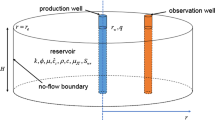Abstract
A mathematical model and a semi-analytical solution to the problem of heating of a production well are proposed, taking into account the effect of thermal dispersion and heat losses through the top and bottom of the reservoir. Using the method of sequential change of stationary states, an approximate solution to the problem without heat losses through the top and bottom of the reservoir is obtained. Nonlinear equations are proposed to assess the well productivity during heating of the bottom-hole zone.




Similar content being viewed by others
REFERENCES
A. B. Sheinman, G. E. Malofeev, and A. I. Sergeev, The Effect on the Formation of Heat during Oil Production (Nedra, Moscow, 1969) [in Russian].
G. G. Vakhitov and E. M. Simkin, Using Physical Fields for Oil Recovery from Reservoirs (Nedra, Moscow, 1985) [in Russian].
R. M. Butler and C. T. Yee, ‘‘Progress in the in situ recovery of heavy oils and bitumen,’’ J. Canad. Pet. Technol. 41, 31–40 (2002). https://doi.org/10.2118/02-01-02
D. Mao, X. Xie, R. M. Jones, A. Harvey, and J. M. Caranikas, ‘‘A simple approach for quantifying accelerated production through heating producer wells,’’ Soc. Pet. Eng. J. 22, 316–326 (2017). https://doi.org/10.2118/181757-PA
A. Shield, ‘‘Theory for the effect of heating oil producing wells,’’ Pet. Trans. 210, 1–10 (1957). https://doi.org/10.2118/684-G
E. V. Teslyuk, Yu. V. Kapyrin, and G. F. Trebin, ‘‘On assessing the effectiveness of thermal stimulation,’’ Neftyan. Khoz-vo 8, 42–49 (1962) [in Russian].
P. E. Morozov, ‘‘Analytical solutions for transient temperature distribution in heavy-oil reservoir due to heating producer well,’’ Lobachevskii J. Math. 41 (7), 1261–1266 (2020). https://doi.org/10.1134/S1995080220070306
M. A. Pudovkin and I. K. Volkov, Boundary Value Problems of the Mathematical Theory of Thermal Conductivity as Applied to the Calculation of Temperature Fields in Oil Reservoirs during Waterflooding (Kazan Univ., Kazan’, 1978) [in Russian].
Y.-Ch. Lin, T. F. Hu, and H. D. Yeh, ‘‘Analytical model for heat transfer accounting for both conduction and dispersion in aquifers with a Robin-type boundary condition at the injection well,’’ Water Resour. Res. 55, 7379–7399 (2019). https://doi.org/10.1029/2019WR024966
V. M. Entov, ‘‘Effective thermal conductivity of a saturated porous medium in the presence of percolation,’’ J. Appl. Mech. Tech. Phys. 5, 108–109 (1965). https://doi.org/10.1007/BF00913403
J. Fuentes, F. Pironti, and A. L. Lopez de Ramos, ‘‘Effective thermal conductivity in a radial-flow packed-bed reactor,’’ Int. J. Thermophys. 19, 781–792 (1998). https://doi.org/10.1023/A:1022630604123
P. E. Morozov, ‘‘The influence of convective thermal conductivity on the temperature field of the reservoir at the radial flow of hot fluid,’’ in Proceedings of the All-Russian Conference on Actual Problems of Continuum Mechanics — 2020 (Kazan Univ., Kazan, 2020), pp. 291–296 [in Russian].
F. M. Bochever, A. E. Oradovskaya, and V. I. Pagurova, ‘‘Convective diffusion of salts in a radial flow of groundwater,’’ J. Appl. Mech. Tech. Phys. 2, 187–88 (1966). https://doi.org/10.1007/BF00916988
G. K. Falade and W. E. Brigham, ‘‘Analysis of radial transport of reactive tracer in porous media,’’ SPE Res. Eng. 4, 85–90 (1989). https://doi.org/10.2118/16033-PA
M. Aichi and K. Akitaya, ‘‘Analytical solution for a radial advection-dispersion equation including both mechanical dispersion and molecular diffusion for a steady-state flow field in a horizontal aquifer caused by a constant rate injection from a well,’’ Hydrol. Res. Lett. 12 (3), 23–27 (2018). https://doi.org/10.3178/hrl.12.23
N. A. Avdonin, ‘‘Some formulas for calculating the temperature field of a stratum subject to thermal injection,’’ Neft’ Gaz 7 (3), 37–41 (1964) [in Russian].
L. I. Rubinshtein, Temperature Fields in Oil Reservoirs (Nedra, Moscow, 1972) [in Russian].
H. Stehfest, ‘‘Algorithm 368: Numerical inversion of Laplace transform,’’ Commun. ACM 13, 47–49 (1970). https://doi.org/10.1145/361953.361969
Author information
Authors and Affiliations
Corresponding author
Additional information
(Submitted by D. A. Gubaidullin)
Rights and permissions
About this article
Cite this article
Morozov, P.E. Evaluating the Influence of Thermal Dispersion on the Reservoir Temperature During Heating of a Production Well. Lobachevskii J Math 42, 2192–2197 (2021). https://doi.org/10.1134/S1995080221090213
Received:
Revised:
Accepted:
Published:
Issue Date:
DOI: https://doi.org/10.1134/S1995080221090213




